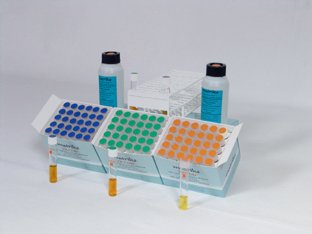
Chemical oxygen demand (COD) is a measure of the capacity of water to consume oxygen during the decomposition of organic matter and the oxidation of inorganic chemicals such as ammonia and nitrite. COD measurements are commonly made on samples of waste waters or of natural waters contaminated by domestic or industrial wastes. Chemical oxygen demand is measured as a standardized laboratory assay in which a closed water sample is incubated with a strong chemical oxidant under specific conditions of temperature and for a particular period of time. A commonly used oxidant in COD assays is potassium dichromate (K2Cr2O7) which is used in combination with boiling sulfuric acid (H2SO4). Because this chemical oxidant is not specific to oxygen-consuming chemicals that are organic or inorganic, both of these sources of oxygen demand are measured in a COD assay.
Chemical oxygen demand is related to biochemical oxygen demand (BOD), another standard test for assaying the oxygen-demanding strength of waste waters. However, biochemicaloxygen demand only measures the amount of oxygen consumed by microbial oxidation and is most relevant to waters rich in organic matter. It is important to understand that COD and BOD do not necessarily measure the same types of oxygen consumption. For example, COD does not measure the oxygen-consuming potential associated with certain dissolved organic compounds such as acetate. However, acetate can be metabolized by microorganisms and would therefore be detected in an assay of BOD. In contrast, the oxygen-consuming potential of cellulose is not measured during a short-term BOD assay, but it is measured during a COD test.
Chemical oxygen demand is related to biochemical oxygen demand (BOD), another standard test for assaying the oxygen-demanding strength of waste waters. However, biochemicaloxygen demand only measures the amount of oxygen consumed by microbial oxidation and is most relevant to waters rich in organic matter. It is important to understand that COD and BOD do not necessarily measure the same types of oxygen consumption. For example, COD does not measure the oxygen-consuming potential associated with certain dissolved organic compounds such as acetate. However, acetate can be metabolized by microorganisms and would therefore be detected in an assay of BOD. In contrast, the oxygen-consuming potential of cellulose is not measured during a short-term BOD assay, but it is measured during a COD test.

No comments:
Post a Comment